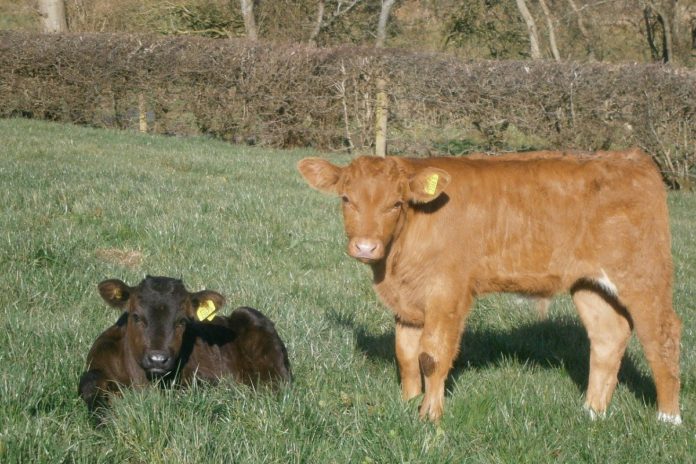The ICBF (Irish Cattle Breeding Federation) has launched a new selection tool called the Commercial Beef Value (CBV).
The federation launched the tool during Teagasc’s virtual beef conference earlier this month.
It believes the tool will be relevant to non-breeding (drystock) breed herds purchasing animals – calves, weanlings, stores – and bringing them to finish.
According to data from the ICBF, approximately 23,000 herds fall into this bracket.
The tool is for non-breeding beef farmers to give them a “better insight” into an animal’s genetic merit.
CBV
The CBV consists of five traits from the terminal Index that are important to a non-breeding drystock enterprise:
- Carcass weight;
- Also, carcass conformation;
- Carcass fat;
- Docility;
- Feed intake.
The CBV is expressed as a € value, like replacement and terminal indexes with both ‘within breed type’ and ‘across breed’ star ratings.
According to ICBF, there are three ‘within breed type’ categories:
- Suckler (beef sire and beef dam);
- Dairy x Beef (one dairy parent and one beef parent);
- Also, Dairy x Dairy (dairy sire and dairy dam).
The ‘within breed type’ star rating will rank animals within that breed-type.
In a statement, the ICBF said:
“Farmers often have a set enterprise in terms of the type of animal they buy i.e. continental suckler weanlings, dairy x beef store heifers, Friesian bull calves.”
“The ‘within breed-type’ star rating will help farmers to identify the highest genetic merit animals within the breed type of interest to them.”
“The CBV will be available to farmers through their ICBF HerdPlus login under the ‘View Profiles’ section.”
CBV values
According to ICBF, generally higher CBV values will mean better performance and higher carcass value.
Therefore, based on the three categories outlined above, it would expect suckler progeny to have higher CBV € compared to dairy X beef and dairy X dairy stock. Still, within each category, you would expect a range.
“Given the potential number of calves that will come from the dairy herd and end up being finished on beef farms, can the CBV be used to signal to dairy farmers what will deliver for beef farmers?”
“The CBV clearly shows that not all Friesian calves are the same nor are all dairy beef-cross calves, and those that have the better genetics are worth more and will be more attractive to the purchaser.”
“If used correctly, it will be a very useful tool for selecting beef animals across all categories. But firstly, we must understand it, begin to use it and signal its relevance to all elements of the supply chain.”
Informed purchasing decisions
At the virtual beef conference on December 6th, ICBF’s Chris Daly said:
“The CBV is not a breeding index. This CBV tool will assist when selecting beef animals to take through to slaughter or perhaps, to graze and sell on again as stores.”
“Farmers need a tool which gives them an insight into the genetic merit of an animal to help them make more informed purchasing decisions.”
“The CBV is essentially the €uro-star terminal index with the calving traits removed. If you think of a drystock farmer buying dairy-beef calves or stores or suckler weanlings, calving traits do not really matter to them.”
“That is important to the breeding dairy or suckler farmer, but not to the person purchasing.”
“The traits included are of economic importance to the farm from the point of purchase forward. You have your feed intake, docility and the three carcass traits: weight, conformation and fat.”
Animals that have and do not have a CBV
He explained the following animals will have CBVs:
- Commercial suckler males and uncalved females;
- All dairy males and dairy-cross beef males;
- Uncalved females.
The following animals will not have a CBV available:
- Pedigree beef males and females;
- Dairy females;
- Calved females.
Data recording
Continuing, Daly said: “Furthermore, there is a plan to roll this out to mart boards in 2022. CBV has the potential to be a vital tool for drystock farmers.”
“High CBV animals are exhibiting higher performance and are giving higher value carcasses at the end. It is equally effective across all breed-types, suckler dairy-cross-beef and dairy.”
“It definitely increases the onus on dairy farmers to use ‘better quality’ higher carcass merit beef sires. In the past, there has been maybe too much of a focus among dairy farmers on using easy calving, short gestation sires.”
“Unfortunately, the correlation between easy calving, short gestation and carcass merit is not great.”
“As you push calving ease and short gestation, you are generally pulling down your carcass traits: carcass conformation and carcass weight. Those really poor quality dairy-beef calves will be highlighted a lot more going forward if the figures are available in marts.”
“Accurate parentage recording will be critical; again, it puts the onus very much on dairy farmers around the recording of sires, particuarly on calves that maybe that do not see as important to their system.”
“Recording the sire breed and not the sire’s identity is not really good enough anymore,” he added.





